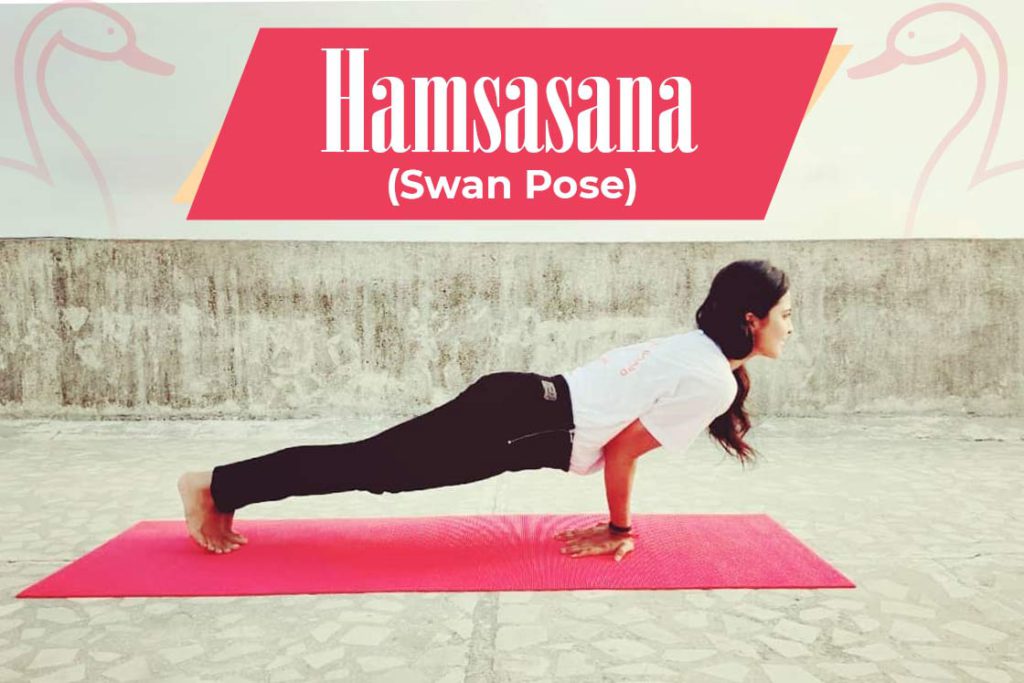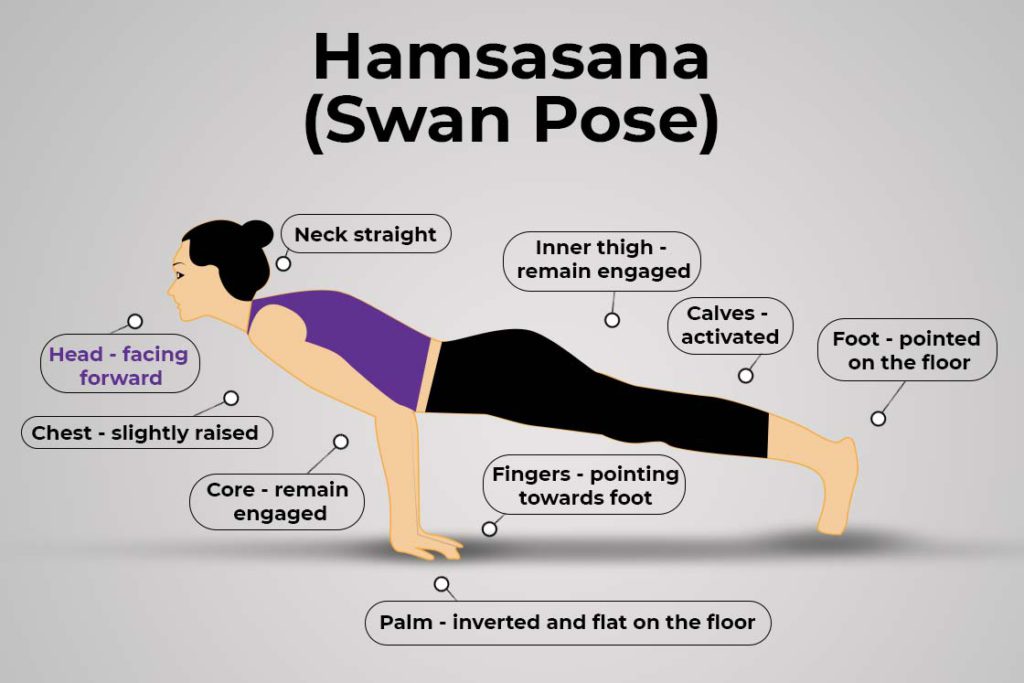
| Sanskrit Pronunciation | Hamsasana (HUM-saa-Suh-nuH) |
| Meaning | Hams = Swan / asana = pose |
| Pose Type | Prone and Balancing |
| Pose Level | Intermediate |
| Anatomy | Core, Palm, elbow, hamstrings |
Swan pose is an intermediate balancing pose that requires the active involvement of the core, glutes, calves, hands, and toes. In this pose, the body is balanced in the prone position. It transforms this asana into one of the challenging ones.
On observing from a distance, This asana looks almost similar to the Plank Pose but with a slight uplift. Hence, the practitioners can prepare their body through the plank pose well, so, they can cherish the challenges of such a beautiful asana.
Meaning
Hamsasana is a Sanskrit word where ‘Hamsa’ means ‘Swan’ and ‘Asana’ means ‘Pose’. However, this asana holds one more understanding if we go deeper into the name itself. ‘Ham’ and ‘Sa’ of the root word represents ‘breath’ and ‘spirit’ respectively. The breath inspired within the practice of this asana awakens the spirit submerged in self-doubts and insecurities. Therefore, makes one delightful, confident and cheerful in life.
Hamsa or Swan is the vehicle of Hindu deity Saraswati, she is well known by the ‘mother or the goddess of knowledge’. Hence, the swan-like concentration in Hamsasana makes the practitioner attentive enough, that he/she grasp things into the mind as none does.
Apart from that, the white color of the Swan represents peace and love. So, practicing this asana enriches one’s inner self with a deep sense of love, compassion, and respect, respectively.
Now let’s practice this pose with guide below;
Practice Guide to Swan Pose
Following steps can be acquired for the safe practice of Hamsasana.
Contraindications
- Swan pose lays pressure on the abdomen, so, the practitioners with pregnancy, menstruation, or even in the postnatal period practicing this asana might be unsafe. Therefore, one should avoid such a phase.
- Patients with High blood pressure condition should refrain from doing Hamsasana, otherwise, the position could give rise to other Heart-related conditions.
- Practitioners who have undergone abdominal, lower back, and waist surgery should avoid performing Hamsasana, as the prone position is supported over core muscles, so it’s not the right choice in the present condition.
- Injury concerning the parts involved in Hamsasana like, wrist, palm, elbows, shoulder, feet are strictly not advisable to continue into the practice. This might worsen the previous condition if ignored.
Preparatory Pose
- Adho Mukha Svanasana (Downward Facing Dog Pose)
- Chaturanga Dandasana (four-limbed pose)
- Vajrasana (Thunderbolt Pose)
How To Do Swan Pose (Hamsasana) Steps

- Begin by coming into Vajrasana (Thunderbolt Pose). Now, separate the knees to bring a gap in between them and place your palm at that place.
- From here, rotate your hand in the manner your fingers pointing your foot and the back of the elbow facing front.
- Slowly bring your pelvis forward and try to firm your abdomen on the base formed by the joining of the elbows. Flex your core muscles to adjust the body, respectively.
- Now, place your head at some distance on the floor in order to assist your legs to become straight. Further, lift your head and try to balance your body weight on the pointed toes and palms.
- Hold your breath or breathe shallowly in this position and maintain the pose as per your ability.
- After which, adjust your head on the floor, bring your legs in the previous position and lift your head by applying some pressure on the abdomen. Release your palm and return to the Vajrasana by reducing the space between the knees, then relax.
Follow up Poses
- Mayurasana (peacock pose)
- Shavasana (Corpse Pose)
Mayurasana is the best follow-up pose after practicing hamsasana for 2-3 rounds. In hamsasana, hamstring, core, quad muscles are prepared in order to lift the body while toes resting on the floor. In mayurasana the legs are raised and toes don’t rest on the floor.
Beginners Tips
- Beginners with not that much strength in their hands should practice the Chaturanga Dandasana. This will fulfill the ability with appropriate conditioning of the entire hand to jump into the Hamsasana.
- It might be difficult for the fresh practitioners to let elbows pressed against the abdomen; especially in case of loose core muscles. Therefore, one should avoid direct practice in such cases or should practice mildly.
- Due to the strenuous nature of this asana practice, the body remains actively involved in this asana. So, beginners should give their extra attention while going into the posture as well as returning. Slow and steady should be the choice in this regard.
Precautions
Keep following points in mind to avoid any injury in swan pose;
- As you spread your knees to place your hands on the floor, make sure the hand is right under the abdomen or on the rectus abdominous muscles. Mare change in position might hurt your internal organs.
- While shifting your body weight on your elbows take the support by landing your head on the floor. However, it will also assist in straightening your leg behind on the toes.
- Avoid dropping off your neck while in the complete Hamsasana. Gazing in the front need your neck to be arched, which helps in activating the mind as well to persist for longer in the asana.
Props and Modifications
- In case of hurting the abdomen while placing the elbow against it, one can place a piece of clothing in order to insulate the pointing effect of the elbows on the abdomen.
- A practitioner who is having discomfort in raising their head to gaze in the front direction can keep a wooden block under their palms. This will add some height to the foundational support, which further assists in straightening the neck.
- Straightening of the legs might require ample practice and developed core muscles. So, the practitioners can drop their knees or can also place a block to support themselves in a pose.
Variations
By applying some changes in the basic posture practitioners can practice these variations of swan pose.
1. Sleeping Swan Pose
Sleeping swan gives a stretch in the hamstring and a slight inward bend in the spine. Whereas, the Hamsasana gives good muscular exercise along with enhancing respiration.
- Begin by coming into the cat pose. All four limbs are aligned to their counterpart.
- Now, bring your right knee in between your hand and straighten your left leg right behind you.
- Slowly slide to right and sit on the right inner thigh. Make a right angle at the knee of the right leg and flex your right foot in front of the left hip.
- From here, the Hand straight and the chest should be open. The shoulder blade remains engaged and back with a slight curve.
- Maintain here as per the comfort. Avoid forced stretching of the leg in here. Now, slowly slide your right foot in and bring your left leg back in its position and come into cat pose.
2. Dolphin Plank One Legged raised
In hamsasana, the body rests upon the palms and pointed toes but the middle part of the body rested on the elbows that make it challenging. However, in dolphin plank one-legged raised pose, the body remains in a forearm plank position with an extra activity of leg raising one by one in the air.
- Begin by coming into the plank pose. The upper body rests on the palms. The lower body on the toes.
- Forearms should align parallel to each other and elbows placed right under the shoulder. Toes tucked on the floor to activate the posture,
- Now, inhale and raise your right leg in the air by engaging your core, glutes, and lower back muscles. Maintain there for few seconds and then exhale to bring the right leg on the floor.
- After which, raise the left leg with inhalation in the air and then bring it to the floor with an exhalation. Perform these steps as the comfort and then release.
3. Plank Pose Four Limbed Staff pose flow
This pose is similar to the first variation of Hamsasana, in which upper body becomes slant upwardly and downwardly at the angle of 135′ and 45′, respectively. Whereas, In Hamsasana, no such shifting of angle is seen and body adjusted on elbows, palms and pointed foot.
- Begin by coming into the Plank pose. Align your hands and legs parallel to each other. Body resting on the toes and palms.
- From here, inhale and give a push through toes, inner thighs, core, and palms to uplift your upper body. After reaching here, try to make your body slant along with straight hands and legs.
- Maintain here for some time and then drop your body down with an exhale. Your body should be just above the floor, elbows bend placed beside the ribs. Maintain here as well and then return into the plank position, respectively.
Therapeutic Benefits
- This asana practice tackles a major issue regarding mental health like stress and anxiety. It improves sleep patterns, which raises confidence and overcomes frequent mood changes.
- Hamsasana, on daily practice, helps in overcoming the forward curve of the spine due to which a person’s upper body looks tilted while standing.
Benefits
Following are some of the best results one gonna experience if he/she practices swan pose on a regular basis.
1. Calms the mind
Hamsasana as the name suggests promotes the quality of swan. Regular practice improves control over the position which further improves patience along with coordination and ultimately calms the mind. According to one study [efn_note] A randomized control trial of the effect of yoga on verbal aggressiveness in normal healthy volunteers https://www.ncbi.nlm.nih.gov/pmc/articles/PMC3144615/ [/efn_note], this asana helps in the reduction of verbal aggression in young age individual as well.
2. Promotes Digestion
The prone position makes the body to rest up on the elbow, which lays pressure on the abdominal region. This gives a massaging affect that improve the functioning of the digestive organs. However, it is also effective in overcoming constipation and piles problem.
3. Strengthens Immunity
This asana require great physical challenge which on holding for some good time enhances breathing. This improves blood circulation, which supplies the necessary requirements to the muscles. Such a process further reduce stress and improves the quality of sleeps. Therefore, strengthens immunity and makes one resistant from various threat.
4. Stabilizes pressure in ears
Himsasana engages respiration as paramount importance to keep alive the energy or fueling the entire body. This process leads to the opening of the eustachian tube [efn_note] eustachian tube https://www.healthline.com/human-body-maps/eustachian-tube [/efn_note] which is the connection between the upper throat and back of the neck. As the air flows through it, it travels through the ear and balances the pressure alongside. This helps in various balancing tasks of daily life.
5. Helpful in Obesity
Hamsasana is one of the strenuous poses which requires the active involvement of muscles, which on being practiced for a longer period burns calories. Apart from that, it also stimulates metabolism which further works at the cellular level to reduce the extra fat from the body. Hence, helps in regulating obesity [efn_note] Obesity and its control through yogic practices https://www.kheljournal.com/archives/2017/vol4issue1/PartB/4-1-28-349.pdf [/efn_note] .
6. Activates Manipura Chakra
The joined elbows in swan pose support the abdomen by placing around the navel region, which is the seat for the Manipura chakra. Regular practice along with appropriate breathing stimulates the energy passing through the subtle channel inside the body. Hence, activates navel chakra.
Conclusion
Hamsasan is one of the strenous asana that improves the overall muscular structure by adding strength into it. It is also helpful in calming the mind by increasing the blood circulation while the asana practice.
Practitioners can enroll this asana to achieve a balance in physical and mental aspect of ones body. In case of normal body type, one can go through variation and modification to reach the top of the mountain in this asana.




